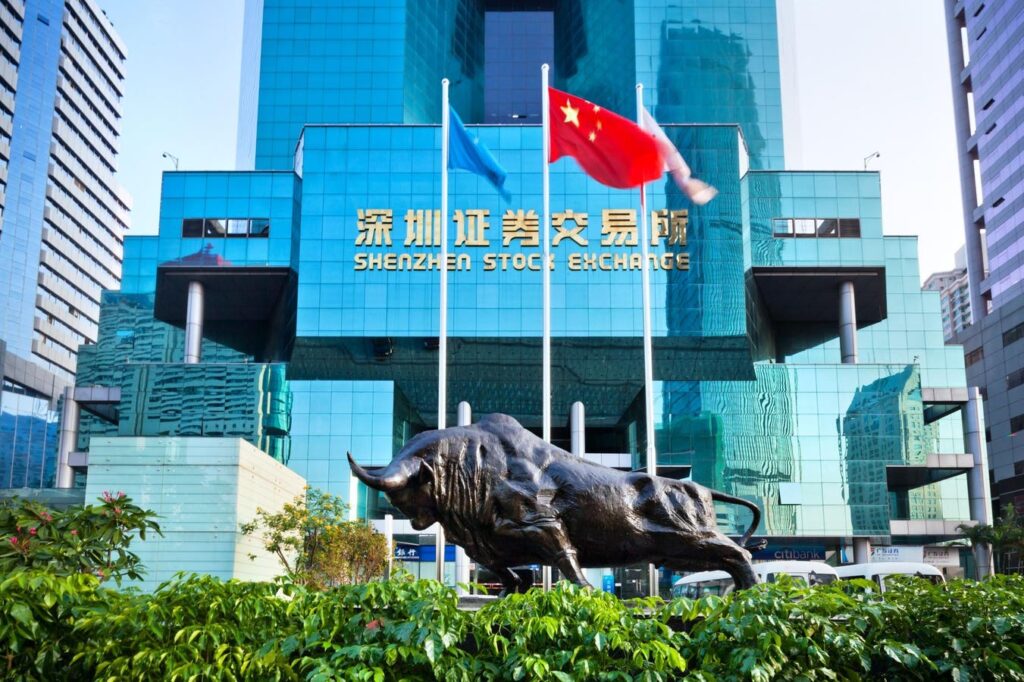China’s government recently took policy actions to support economic growth by bolstering the country’s property market and stock market. They represent a sea change from President Xi Jinping’s previous stance in which he refrained from undertaking bold government stimulus.
Traders, investors and speculators have responded enthusiastically to the policy announcements: The 15% increase in the benchmark CSI-300 index last week and an 8.5% rise early on Monday represents the strongest showing since 2008. According to Bloomberg, the index has entered a technical bull market after it had declined by more than 45% from its high in 2021 through mid-September (see chart below).
The policy shift began when the People’s Bank of China announced it would cut interest rates, lower reserve requirements and reduce the cost of existing mortgages. The PBoC will also take unprecedented action to bolster the stock market, enabling market participants to borrow government bonds from the bank by using stocks as collateral in order to strengthen their balance sheets.
China’s Politburo subsequently devoted its September meeting to the economy, where it resolved to arrest the property market’s slide. According to Reuter’s, it will issue an additional 2 trillion yuan of bonds, which is equivalent to about 1.5% of GDP. Half of the proceeds will be used to backstop local governments, while the other half will encourage spending by households and businesses.
These measures represent about one half of the “bazooka” package China deployed during the 2008 global financial crisis. The final tally eventually reached about 9.5 trillion yuan over more than two years, which is widely credited for China’s economy leading the global recovery.
The main question today is whether the latest actions will serve as a catalyst to revive China’s economy and renew foreign capital inflows. Previously, China’s equity markets had been among the worst performers globally. Bank of America’s latest Global Fund Manager Survey showed growth expectations for China were at a three-year low, and the report stated that “avoid China” had become one of the biggest themes of investors it surveyed.
By comparison, eight out of 12 investors in a Bloomberg survey last week believed the actions will be the turning point for a long-term rally, while four viewed it as a short-term rebound.
My take is the rally may continue for a while longer. The main reason is the market selloff over the last three years has left Chinese stocks relatively cheap. For example, China’s forward price-to-earning ratio is roughly half of the U.S.’ S&P 500 index. Consequently, global equity managers may increase their allocations to Chinese equities since most are considerably underweight. In addition, the policy actions could give the economy a temporary lift, which would help improve investor confidence.
Nonetheless, I remain skeptical that China’s equity markets are a good long-term strategic play. The principal reason is the economic slowdown in recent years is mainly a result of structural forces rather than cyclical forces, and China’s leaders appear reluctant to embark on much-needed economic reforms.
One of the biggest challenges for policymakers to bolster China’s long-term growth is its population growth has stagnated owing to the former one-child policy. Even though this policy has been repealed, China faces declines in its population from 1.4 billion to 1.3 billion by the middle of this century, according to the latest United Nations report.
Another challenge is the property sector is plagued by an excess supply of housing units that is estimated to exceed 7 million homes, according to Reuters. Government statistics show prices for new and existing homes are down by 5% and 8%, respectively, over the past three years. Bloomberg economics estimates that a 5% decline in home prices could wipe out up to $2.7 trillion in household net worth.
It is also widely acknowledged that Chinese households need to spend more and save less to bolster economic growth. Yet, the lack of a social safety net makes it difficult for this to happen. Furthermore, household debt has more than doubled in the past decade, and deflationary pressures are building that make it harder to lessen the debt burden.
Meanwhile, one of the biggest mistakes the government made three years ago was to clamp down on leading technology companies such as Alibaba and Tencent. According to the Financial Times, fundraising for both domestic and overseas venture capital has “fallen off a cliff” since 2022. Yet the government has not acknowledged that the shift to favor state-owned entities over private enterprises is likely to hamper efforts to boost China’s productivity, which has been on a slowing trend.
Finally, China’s strategy to emphasize export-led growth in electronic vehicles and other manufactures faces a growing backlash in the U.S. and European Union, both of which have increased tariffs on imports from China in recent years. Moreover, former U.S. President and 2024 GOP nominee Donald Trump has threatened to increase tariffs on Chinese goods by as much as 60%, should he win the election.
For these reasons, I believe global investors need to be nimble if they jump on board the rally in Chinese stocks.
Read the full article here

